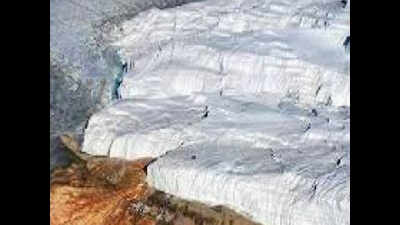- News
- City News
- dehradun News
- Glaciers in Sikkim melting faster than other parts of Himalayan region: Study
Trending
This story is from March 25, 2020
Glaciers in Sikkim melting faster than other parts of Himalayan region: Study
The impact of global warming on Himalayan glaciers is not a secret, but a study by scientists from a Dehradun-based institution under ministry of science and technology has now found an added cause of concern observing that the glaciers in Sikkim are melting faster than other parts of the Himalayan regions.

Gangotri is the source of the Bhagirathi river, which eventually feeds the Ganga.
NEW DELHI: The impact of global warming on Himalayan glaciers is not a secret, but a study by scientists from a Dehradun-based institution under ministry of science and technology has now found an added cause of concern observing that the glaciers in Sikkim are melting faster than other parts of the Himalayan regions.
The study, for the first time, analysed multiple glacier parameters such as length, area, debris cover, snow line altitude (SLA), glacial lakes and velocity, and explored interlinkage among them to present a clear picture about status and behaviour of glaciers in Sikkim.
The department of science & technology (DST) under the ministry shared the findings, conducted by scientists from the Wadia Institute of Himalayan Geology (WIHG), on Monday. These may help in creating awareness among common people regarding water supplies and possible glacier hazards, particularly to those communities that are living in close proximity in the region.
The study, published in Science of the Total Environment, assessed the response of 23 glaciers of Sikkim to climate change for the period 1991-2015 and revealed that glaciers in Sikkim have retreated and deglaciated significantly from 1991 to 2015.
“Small-sized glaciers in Sikkim are retreating while larger glaciers are thinning due to climate change, “ said the DST in its note on the new study, adding that the summer temperature rise has been prime driver of glacier changes.
Though a generalized mass loss is observed for both small (less than 3 km square) and large-sized glaciers (greater than 10 km square), they seem to adopt different mechanisms to cope with the ongoing climatic changes. “While the first adjust mostly by deglaciation, the latter lose mass through down wasting or thinning,” said the DST.
As far as entire Indian Himalayan region is concerned, the country’s national space agency - Indian Space Research Organization (ISRO) - has monitored the glacier advance and retreat of 2,018 glaciers, using satellite data of 2000-01 to 2010-11. Its analysis shows that 87% of glaciers showed no change, 12% glaciers retreated, and 1% glaciers have advanced.
The rate of melting varies from glacier to glacier depending on topography and climatic variability of the region. While, the glaciers in the eastern and central part of Indian Himalaya are continuously retreating, some of the glaciers in the Western part of Himalaya are reported to be stable or advancing.
The study, for the first time, analysed multiple glacier parameters such as length, area, debris cover, snow line altitude (SLA), glacial lakes and velocity, and explored interlinkage among them to present a clear picture about status and behaviour of glaciers in Sikkim.
The department of science & technology (DST) under the ministry shared the findings, conducted by scientists from the Wadia Institute of Himalayan Geology (WIHG), on Monday. These may help in creating awareness among common people regarding water supplies and possible glacier hazards, particularly to those communities that are living in close proximity in the region.
The study, published in Science of the Total Environment, assessed the response of 23 glaciers of Sikkim to climate change for the period 1991-2015 and revealed that glaciers in Sikkim have retreated and deglaciated significantly from 1991 to 2015.
Before this, the Sikkim glaciers had been poorly studied, and field-based mass balance measurements had been limited to only one glacier (Changme Khangpu) and for a short period (1980-1987).
“Small-sized glaciers in Sikkim are retreating while larger glaciers are thinning due to climate change, “ said the DST in its note on the new study, adding that the summer temperature rise has been prime driver of glacier changes.
Though a generalized mass loss is observed for both small (less than 3 km square) and large-sized glaciers (greater than 10 km square), they seem to adopt different mechanisms to cope with the ongoing climatic changes. “While the first adjust mostly by deglaciation, the latter lose mass through down wasting or thinning,” said the DST.
As far as entire Indian Himalayan region is concerned, the country’s national space agency - Indian Space Research Organization (ISRO) - has monitored the glacier advance and retreat of 2,018 glaciers, using satellite data of 2000-01 to 2010-11. Its analysis shows that 87% of glaciers showed no change, 12% glaciers retreated, and 1% glaciers have advanced.
The rate of melting varies from glacier to glacier depending on topography and climatic variability of the region. While, the glaciers in the eastern and central part of Indian Himalaya are continuously retreating, some of the glaciers in the Western part of Himalaya are reported to be stable or advancing.
End of Article
FOLLOW US ON SOCIAL MEDIA











